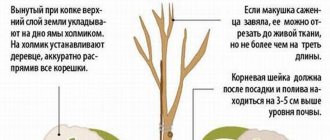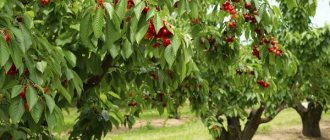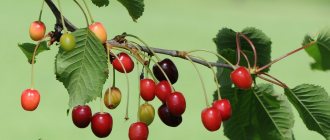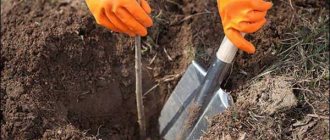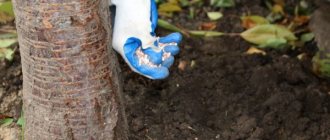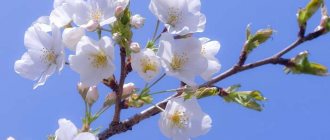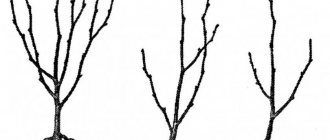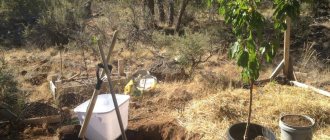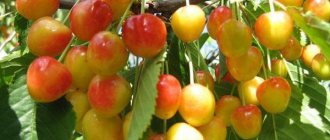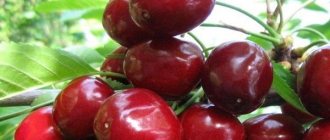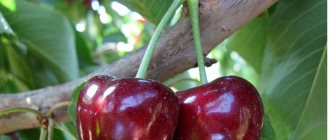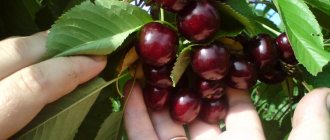Description of the variety
Trees of this variety are characterized by:
- straight trunk no more than 3 meters long;
- practically no side shoots;
- decorative oval shape;
- no need for annual pruning.
The fruits of the Silvia cherry can be described as follows:
- large size;
- dark red color;
- high taste qualities;
- the pulp is dense and juicy;
- the peel is durable and not subject to cracking;
- retain their appearance and taste for a long time if stored correctly (in the refrigerator - about 3 weeks).
Silvia cherries can be grown in southern and central Russia, Ukraine and the southern part of Belarus without any problems. For more northern regions, careful treatment and insulation of trees will be required.
Characteristics
This variety is unpretentious to grow, but still has its own characteristics that you must know before planting.
Among the main characteristics of the columnar cherry Sylvia are:
- resistance to drought and frost;
- pollination, flowering and ripening;
- productivity;
- resistance to diseases and pests.
Resistance to drought and frost
This variety has average resistance to such weather conditions.
Pollination, flowering and maturation
Sweet cherries Sylvia and Cordia, as well as Helena and Sam, are mutually pollinating, so experts advise planting them nearby. Flowering is late, but the color can withstand frosts down to -2. Fruit ripening occurs in the first half of June (12-18th).
Productivity
Cherry fruiting lasts a week to a week and a half. The first harvest can be obtained already in the second or third year of the plant’s life. In the first and second years, experts recommend removing all the ovaries to allow the seedling to take root in a new place, but in the second year, many are already collecting fruits. The yield in the third year, with proper care, is about 15 kg per tree. Older trees can bring 50 kg per plant. Due to high fruiting, the life span of such trees is about 15 years.
Resistance to diseases and pests
The Silvia variety has shown high resistance to various diseases, including fungal ones. For better resistance to pests and protection from the sun, it is recommended to bleach the tree trunk.
Advantages and disadvantages
Among the advantages are:
- compact dimensions;
- decorativeness;
- large and tasty berries;
- resistance to frost, drought and atmospheric moisture;
- early maturation;
- Growing and caring for Sylvia cherries does not require much effort.
Among the disadvantages of this variety are:
- does not tolerate winds, especially northern ones;
- does not like excess moisture in the soil, which interferes with the supply of oxygen;
- despite its dislike for excess water, it does not tolerate severe drying out;
- need for abundant sunlight;
- does not like weeds and large vegetation.
Reviews of the columnar cherry Little Sylvia say that it has retained almost all the properties of its older sister, but has become even smaller in height and diameter - up to 2 meters and 0.5 meters, respectively. The fruits also ripen later.
How to plant Columnar cherries
Despite the unpretentiousness of columnar cherry varieties, in order to fully develop and obtain a good harvest, a number of agrotechnical measures for planting and further care must be observed. For placement, select a sunny area, with protection from through winds and with light shading from the midday heat. The soil is preferably loose and fertile, with distant groundwater flows.
How to choose a seedling
You need to buy seedlings in specialized gardening stores or nurseries. Sales through Internet resources are no less popular now. The latter method is less reliable, since there is no way to visually familiarize yourself with the purchased varieties in advance.
When purchasing columnar cherry seedlings, they are guided by a number of factors:
- The presence of living and uninjured ovaries on the apical part of the shoot.
- Smooth trunk without any deformation.
- The presence of rot and growths on the root system of columnar cherries is unacceptable.
- Foliage, if present, must be consistent with the age of the seedling and show no signs of disease.
Planting dates and scheme
The timing of planting Colonoid cherry seedlings varies, which is influenced by location: in the north - in spring, in the south - in autumn. Late planting is predicted several weeks before the first cold snap, spring planting - after warm weather sets in.
How to plant columnar cherries in spring or autumn:
- Dig a hole of the appropriate size so that the roots are not crowded in it.
- They correctly determine at what distance to plant columnar cherries - the permissible limit is 2-3 meters. The interval between rows is 1.5 m.
- Place the cherry seedling in a hole, having previously treated the rhizome with clay mash, and cover it with soil. The root collar is left open 2-3 centimeters above ground level. Otherwise the tree will die.
- Upon completion of planting work, the seedling is abundantly moistened.
- Dig shallow grooves in the root space to make future watering more convenient.
Pit preparation
The hole is dug to approximately a depth of 80. The diameter is selected to suit the root system so that the shoots fit without creases. If groundwater is close to the ground, drainage is laid out at the bottom of the hole: expanded clay, brick chips. A soil mixture is poured into the center in a heap, which is prepared in advance: humus and black soil, in a ratio of 1:3. Potassium and phosphorus fertilizers of 17 and 12 g are added to them.
Cherry Sylvia and other varieties of columnar cherries
Columnar cherry is a plant that is still new in our gardens, however, it is already loved by many gardeners. A compact bush with an abundant harvest of berries both decorates the garden and is a source of healthy and tasty fruits. In the article we will talk about the varieties of columnar cherries: we will find out which of them are the most popular today, find out their features, and figure out which ones are suitable for cold climates and which ones are suitable for milder ones. We will also get acquainted with the reviews of those gardeners who are already growing this wonderful plant on their plots.
Reviews of columnar cherries
It is difficult to find a good columnar cherry seedling, many gardeners complain about this, but in terms of cultivation, reviews about these trees are mostly positive.
- Diana Terentyeva : “We planted columnar cherries because there was simply not enough space on the plot. At first we spent a long time choosing, then we ordered the “Iput” variety. After about 2-3 years, the first berries appeared. At first it was small, but every year the harvest is increasing. The berries are tasty, like ordinary cherries, sweet, but larger. I like that the tree does not take up much space and provides almost no shade - you can plant greens or other plants under it. So I recommend it to everyone."
- Vadim Stokar : “My wife and I have tried to grow all sorts of unusual trees in our garden. There were good experiments and unsuccessful ones. About 3 years ago we purchased columnar cherries “Black”. It didn’t take long to take root, and soon the leaves began to grow (they were planted in the spring). This year we tried the first berries. Very tasty - sweet. Berries are a sight for sore eyes. Now we will look for other columnar tree species, because they really save space on the site.”
- Alexandra Grischuk : “Initially I thought that the columnar cherry was the most unpretentious tree, but it turns out that it requires constant care. At first you just need to find a good place for it, but then, when it grows up, it is important to water it on time and feed it. With any delays or delays, it begins to fade and slow down development. We make sure to insulate it for the winter so as not to risk it. But, in general, my impressions are satisfactory. A fruitful tree produces very tasty berries, so time is not wasted.”
Columnar cherry Sylvia is one of the most popular varieties of compact fruit trees. Columnar trees gained their popularity primarily in industry, and then moved into households. Their clear advantage is their small size, which makes dense planting possible (at a distance of 1 meter).
Description and characteristics of good columnar varieties of cherries
Columnar cherry, unlike a regular cherry, is just a trunk with a small number of leaves on it. There are practically no spreading branches as such. The plant can reach four meters in height. Such cherries bear fruit very profusely: the entire trunk is literally strewn with berries. It got its name due to its appearance, reminiscent of a column.
Judging by the description of the cherry variety Valery Chkalov, in order for the plant to grow and bear fruit safely, it needs to be provided with good lighting, as well as protection from the wind. Sometimes, from strong gusts of wind, tall and unprotected by branches, fragile trunks of columnar cherries break. The plant does not need pruning, which greatly simplifies the gardener’s life. However, cherries are demanding when it comes to watering: they do not tolerate drying out of the soil, as well as severe waterlogging, especially stagnation of groundwater.
The video shows the features of planting columnar cherries:
Columnar cherries must be covered for the winter, even if the variety is frost-resistant. However, this work can be done quite quickly - the shape of the plant with the absence of protruding branches does not interfere with covering.
pros
The plant is characterized by high productivity. It bears fruit for the first time already in the same year when the seedling was grafted. The berries of columnar cherries are very tasty, large and juicy.
Due to the fact that the bush is compact, it is easier to care for, and it takes up less space on the site and does not create shadows with branches. The plant does not need thorough pruning: only a light sanitary procedure is carried out periodically.
The plant is also distinguished by its high decorative qualities.
Advantages and disadvantages
Columnar cherries have a lot of positive qualities.
- The tree takes up minimal space on the site.
- No pruning needed. And this greatly simplifies care, especially for young gardeners. Only in rare cases can sanitary pruning be carried out if the pagons are frozen or some diseases appear.
- Productivity is high, regardless of the variety.
- The first fruiting is observed in the year the seedling is grafted. If the tree is planted, then the harvest can be expected for about 3 years.
- The berries are tasty, usually large and juicy.
- The harvest can be harvested either manually or mechanized.
Although there are not many disadvantages of this type of cherry, they do exist.
- Such trees need to be planted next to natural or artificial protection from the winds, because during a storm the branches and the tree trunk itself can break.
- The tree requires watering. It does not tolerate drought, but it will not be able to develop normally in marshy soil.
- Productivity is considered high for a columnar tree. But since these trees do not have many branches, about 15 kg of berries are collected per tree. Compared to simple cherries, this is not much. But if you grow berries for your own needs, and not for sale, then the harvest will be enough.
Varieties
Let's get acquainted with the most popular varieties of columnar cherries.
One of the most commonly used in industrial gardening. It is often used as a pollinator for other varieties of columnar cherries, as it can significantly increase their yield.
The tree can bear fruit for 15 years. It ripens earlier than all other varieties: already on June 10 you can start enjoying the delicious berries.
Sabrina
This is a self-fertile plant reaching a height of 2.5 meters. The diameter of the crown is quite voluminous, it can reach a meter. The yield is good, you can start picking berries from the end of June.
The Sabrina variety has large juicy fruits with tasty pulp. The tree has average frost resistance and is more suitable for growing in mild climates. But it is highly resistant to pests and diseases.
Helena
Ovstuzhenka and Helena cherries are ideal for the middle zone regions. Very productive, the berries are a little hard, with red-pink flesh. The harvest ripens in this case on June 18-25. Refers to dessert varieties. The tree itself reaches a height of three meters, and the column can be a meter wide. Columnar cherries of the Helena variety bear fruit from 15 to 25 years.
Yellow
Varieties of columnar cherries with yellow fruits have their own advantages. In this case, you don’t have to be afraid that the berries will be pecked by birds, since the latter eat only red varieties of cherries.
Yellow cherries are usually distinguished by good productivity and longevity: they can bear fruit for up to 25 years. Photos and descriptions of the Napoleon cherry variety can be seen at this link.
Black
Extremely unpretentious, and at the same time a high-yielding tree. Black columnar cherries can also be grown in harsh Siberian conditions. It is never tall - the plant reaches a maximum height of one and a half to two meters.
It has characteristic fruits - dark red, almost black, very large, with a pleasant glossy shine.
Silvia
Often grown in the middle zone. The tree is not very resistant to frost, however, when covered for the winter, it copes well with the climate of the middle zone. The harvest ripens on June 12-18.
This is a frost-resistant variety, which makes it possible to grow it in Siberia. However, the tree requires mandatory shelter from the wind. The plant is not distinguished by its compact size: it can reach a height of 4 meters, and the diameter of the crown is one and a half meters.
Little Sylvia
This is a more miniature analogue of the Sylvia variety: in this case, the tree is not taller than two meters in height. The crown of the plant does not reach half a meter in diameter. The fruits ripen at the end of June; the taste of the dessert berries is similar to Helena. Find out about the description of the Fatezh cherry variety from this material.
Queen Mary
This variety has average frost resistance, so it is more suitable for the middle zone. However, he compensates for his fear of cold weather with the excellent taste of the berries and high yield. Up to 15 kg of berries are collected from one tree per season. Suitable for growing in the Moscow region.
Baby
This columnar cherry variety boasts high yields despite its small size and compactness. The plant rarely reaches two meters in height, usually stopping growth when it reaches one and a half meters. Crown diameter - 80 cm.
The taste of the berries in this case is sweet and sour, very pleasant, and the fruits have a wonderful fragrant aroma. You can eat the berries fresh, and they are also suitable for canning. The Malyutka variety can also be grown in Siberia, as it has sufficient frost resistance. However, the plant definitely needs reliable shelter for the winter.
What a forest beauty pear looks like and how it can be planted. is described in the article at the link.
You can find out about the description of the Cathedral Pear here.
Delight
Columnar cherries of this variety have a medium-early ripening period. It has a fairly high yield, and without jumps, it is stable. The berries are large, weigh from 11 to 14 grams, and have a rich ruby color. It will also be interesting to learn about the description of the Severyanka pear.
The fruits have tasty, juicy pulp and are very good fresh. The Vostorg variety is resistant to most diseases that threaten cherries. It begins to bear fruit in the second or third year after planting. You may also be interested in the process of planting the Chizhovskaya pear, as well as information about the fruits of this plant.
And the way
A high-yielding variety, loved by many gardeners. The berries are not too large, but very sweet and tasty, the pulp is easily separated from the drupe. The color of the fruit is dark burgundy. The berries of this variety, unlike many other varieties, have excellent transportable properties: this makes it possible to grow the “Iput” variety on an industrial basis.
The fruits ripen early, ending fruiting by June 18-22. The plant has excellent natural resistance to various diseases. But you can find out how to plant a pear in memory of Yakovlev by clicking on the link.
Revna
The variety has excellent taste: the berries are juicy, sweet, and also have a high level of keeping quality. All one berries range from 5 to 8 grams. Harvesting can begin in early July. The plant is frost-resistant; it can also be grown in Siberia. In addition, the columnar cherries of this variety are highly resistant to fungal infections and also have excellent resistance to sunburn. It will also be interesting to know what the rules are for planting columnar pears.
Tyutchevka
The Tyutchevka cherry variety is a mid-season variety, with harvest beginning in early July. It has beautiful dark red berries, with thick skin and elastic pulp. The berries are small - 3.5-4.5 grams, however, tasty, the tree's yield is high. The latter property is achieved due to the plant’s ability to self-pollinate. Sweet cherry variety Tyutchevka is capable of bearing fruit for 18-25 years. Read about reviews about the Iput cherry variety here.
Recommendations
Some useful tips for more rational and competent cultivation of columnar cherries on your plot.
If you want to increase your plant productivity, plant several different varieties nearby. In this way, plant pollination will occur, which will help make the berries larger, juicier, and tasty, and the harvest more abundant. Most often, Sem cherries are planted next to trees of other varieties for pollination and improved productivity.
Do not forget that only a few varieties of columnar cherries are suitable for growing in cold regions. Still, for the most part, these plants are intended for milder climates. Although breeders are actively working in this direction, and perhaps new interesting frost-resistant varieties will soon be developed.
It is important to take into account that columnar cherries are quite demanding in terms of soil composition. It is important that the soil is fertile and contains all the necessary microelements.
Reviews
- Tatyana, Lipetsk: “I’ve been growing columnar cherries on the plot for the fifth year now. I have several varieties - Tyutchevka, Sem, Chernaya and Sylvia. They all grow nearby, they don’t take up much space, I cover them for the winter. They bear fruit well and pollinate on their own. I'm happy - the care is simple, and the harvest is good. Plus, they bloom very beautifully.”
- Sergey, Novosibirsk: “I thought for a long time about how to grow cherries in our climate, I rummaged through a bunch of literature on this topic. In the end, I settled on a columnar variety and chose the Revna and Silvia varieties. Both trees grow well, bear fruit regularly, but they still need to be well covered for the winter, since in the first year they froze a little. In general, they are quite suitable for our climate, the berries themselves are very tasty, I am satisfied.”
We looked at the characteristics of different varieties of columnar cherries. As you can see, although this type of plant is still new, its potential is already visible, and the prospects for growing such cherries are very encouraging. Choose a suitable variety of columnar cherries, based first of all on the climatic conditions of your region, and then pay attention to productivity, decorativeness and other important qualities. This article will tell you about the description and characteristics of the Bull's Heart cherry variety.
Reviews from gardeners
Gardeners who grew Sylvia cherries have mixed opinions about them. On specialized forums there are both positive and negative reviews.
Lyudmila, Sevastopol: “We planted several varieties of columnar cherries at once - Sylvia and Helena. They have been growing with us for 4 years. They took it well, never got sick during this time, and there were no pests either. We have to water frequently and abundantly, because our climate is hot and dry. The berries are tasty and large. We were told that they would be the same, but it seems to me that Sylvia is still sweeter and larger-fruited. In the first year of fruiting, we collected a bucket of berries from each tree.”
Anatoly, Svetlograd: “I planted Sylvia and Sam at the dacha, they bore fruit perfectly for 3 years, I was pleased, but then Sylvia began to grow strongly to the sides, even the top. On forums on the Internet they advised to prune. This year I did everything as recommended, but after that the yield dropped significantly.”
Cherry variety Silvia - Four-year-old trees on VSL rootstock - 2
Related posts:
No comments yet.
You must be logged in to leave a comment.
Cherry on rootstock VSL-2 grade Tehlovan
1 year ago - No comments
Similar posts:Digging up annual pear seedlings with a crownFor farms and entrepreneurs!Matsenko NurseryAnnual cherry seedlings - season 2015Apple seedlings - soil preparation 2014 - VIDEO
Cherry Sylvia on rootstock VSL-2 six-year-old trees!
1 year ago - No comments
Similar posts: Digging up annual pear seedlings with a crown Matsenko Nursery For farms and entrepreneurs! Annual cherry seedlings - season 2015 Apple tree seedlings - soil preparation 2014 - VIDEO
Planting an intensive cherry orchard - Matsenko nursery
1 year ago - No comments
Similar posts: Digging up annual pear seedlings with crowns Annual cherry seedlings - 2015 season For farms and entrepreneurs! Budding of fruit trees - Preparation. Matsenko nursery Apple tree seedlings - soil preparation 2014 - VIDEO
Intensive planting of dwarf cherries
1 year ago - No comments
Similar posts:Digging up annual pear seedlings with a crownFor farms and entrepreneurs!Matsenko NurseryAnnual cherry seedlings - season 2015Apple seedlings - soil preparation 2014 - VIDEO
Flowering of an intensive cherry garden on VSL-2 rootstock
1 year ago - No comments
Similar posts: Digging up annual pear seedlings with crowns Annual cherry seedlings - 2015 season For farms and entrepreneurs! Budding of fruit trees - Preparation. Matsenko nursery Apple tree seedlings - soil preparation 2014 - VIDEO
Spring pruning of an intensive cherry orchard
1 year ago - No comments
Similar posts: Digging up annual pear seedlings with a crown For farms and entrepreneurs! Matsenko Nursery Digging up apple tree seedlings Knip-Baum 2021. The advantage of forming cherry trees directly in the nursery for the UFO, KGB and spindle-shaped crown systems. Part 2
About the intensive cherry orchard on VSL 2 rootstock
1 year ago - No comments
Similar posts: Digging up annual pear seedlings with a crown Apple tree seedlings - planting 2 x Knip-Baum entrances The advantage of forming cherries directly in the nursery for the UFO, KGB and spindle-shaped crown systems. Part 2 Odessa region. Planting an intensive cherry orchard on the VSL-2 rootstock, large-fruited varieties. Budding of the VSL-2 rootstock with cherry varieties.
Summer pruning of an intensive dwarf Cherry Garden
2 years ago - No comments
Similar posts: Digging up annual pear seedlings with a crown The advantage of forming cherry trees directly in the nursery for the UFO, KGB and spindle-shaped crown systems. Part 2 Intensive peach garden on Manzhursky rootstock. Variety Flemin Furi 24-007 Digging up apple tree seedlings Knip - Baum 2021. Matsenko Nursery - 2019
Cherry variety Lapinz on Vsl-2 rootstock
2 years ago - No comments
Similar posts: Digging up annual pear seedlings with a crown Apple tree seedlings - planting 2 x Knip-Baum entrances The advantage of forming cherries directly in the nursery for the UFO, KGB and spindle-shaped crown systems. Part 2 Odessa region. Planting an intensive cherry orchard on the VSL-2 rootstock, large-fruited varieties. Budding of the VSL-2 rootstock with cherry varieties.
Cherry on Vsl-2 or Gisella
2 years ago - No comments
Similar posts: Digging up annual pear seedlings with a crown Apple tree seedlings - planting 2 x Knip-Baum entrances The advantage of forming cherries directly in the nursery for the UFO, KGB and spindle-shaped crown systems. Part 2 Odessa region. Planting an intensive cherry orchard on the VSL-2 rootstock, large-fruited varieties. Budding of the VSL-2 rootstock with cherry varieties.
Characteristics of fruits and trees
Columnar trees are significantly different from ordinary ones, but in order to distinguish the Sylvia cherry from the rest, you need to know its description in more detail.
Crown height and density
Columnar trees are dwarf. The height of Sylvia, even on a wild rootstock, does not exceed 3 m. Its trunk is erect and has practically no lateral branches. All shoots grow vertically. The crown is dense, cylindrical. It requires virtually no shaping.
Scientists have also developed a variety of the Sylvia variety - Little Sylvia
Taste qualities of fruits
Ripe berries are dark red in color with shiny skin. Fruit density is average. The flesh is deep red, crispy, juicy. Its taste is excellent and bright. In terms of taste, Sylvia was rated 4.9 points out of 5 possible.
Frost resistance
The variety is suitable for cultivation in the south and mid-latitudes of Russia, in Ukraine and in the south of Belarus. To the north, the tree can grow, but only with good insulation for the winter, since its frost resistance is average.
Productivity of the variety
The variety bears fruit in 7–10 days. The tree bears fruit for the first time in the second or third year. In the first and second years, it is advisable to cut off the entire ovary so that the tree does not waste energy on ripening the fruits, but directs them to rooting. If you follow all the rules of care, then in the third year you can already get about 15 kg of berries from the plant. Older adults bring 50 kg. Such high productivity has a downside - the tree lives no more than 15 years.
Advantages and disadvantages of the variety
- The positive qualities of the variety include:
- compactness;
- decorativeness;
- large fruit;
- excellent taste;
- frost resistance, drought resistance, moisture resistance;
- unpretentiousness.
- The disadvantages of this variety are:
- does not tolerate strong and cold winds;
- does not like overly wet soil;
- does not tolerate prolonged drought;
- does not like weeds, as well as the proximity of other tall plants.
Cherry Silvia: description of the variety, characteristics, features of planting and care, photos
Cherry Sylvia is a popular variety of columnar (compact) fruit trees. It is in great demand on an industrial scale, but amateur gardeners also like it due to its small size. We’ll tell you further how to grow such a plant on your property.
Botanical description of the variety
Columnar cherries are varieties of this crop that grow in height. An adult plant looks like a narrow cylinder, densely dotted with fruits.
It seems that the fruits grow on the trunk itself, and not on the branches, since excessive branching is not inherent in columnar cherries, and the shoots are very short.
The tree blooms late, so the berries ripen only by mid-June. The fruits grow large and juicy.
Important! Blooming cherry Sylvia can withstand frosts down to -2
°
With no loss of color.
Characteristics of fruits and trees
Columnar trees are significantly different from ordinary ones, but in order to distinguish the Sylvia cherry from the rest, you need to know its description in more detail.
Crown height and density
Columnar trees are dwarf. The height of Sylvia, even on a wild rootstock, does not exceed 3 m. Its trunk is erect and has practically no lateral branches. All shoots grow vertically. The crown is dense, cylindrical. It practically does not require shaping. Scientists have also developed a variety of the Sylvia variety - Little Sylvia
Taste qualities of fruits
Ripe berries are dark red in color with shiny skin. Fruit density is average. The flesh is deep red, crispy, juicy. Its taste is excellent and bright. In terms of taste, Sylvia was rated 4.9 points out of 5 possible.
Frost resistance
The variety is suitable for cultivation in the south and mid-latitudes of Russia, in Ukraine and in the south of Belarus. To the north, the tree can grow, but only with good insulation for the winter, since its frost resistance is average.
Productivity of the variety
The variety bears fruit in 7–10 days. The tree bears fruit for the first time in the second or third year.
In the first and second years, it is advisable to cut off the entire ovary so that the tree does not waste energy on ripening the fruits, but directs them to rooting.
If you follow all the rules of care, then in the third year you can already get about 15 kg of berries from the plant. Older adults bring 50 kg. Such high productivity has a downside - the tree lives no more than 15 years.
Advantages and disadvantages of the variety
- The positive qualities of the variety include:
- compactness;
- decorativeness;
- large fruit;
- excellent taste;
- frost resistance, drought resistance, moisture resistance;
- unpretentiousness.
- The disadvantages of this variety are:
- does not tolerate strong and cold winds;
- does not like overly wet soil;
- does not tolerate prolonged drought;
- does not like weeds, as well as the proximity of other tall plants.
Features of planting cherries
Since this cherry tree is compact and short, it has its own planting requirements.
Important! The Sylvia cherry has a subspecies, Little Sylvia, with a height of no more than 200 cm and a diameter of up to 50 cm. Its ripening period is even later.
Landing dates
It is best to plant columnar cherries in the spring, after the frosts have passed. If the seedling was purchased in the fall, then it should simply be buried and in the spring, at the beginning of April, planted in a permanent place.
Choosing a landing site
Light soils (sandy loam, coarse sandy, loam) are suitable for cherries. In addition, the soil must be loose, water- and breathable so that the tree can more easily survive frosts. The culture does not like to be replanted, especially at the age of 3–4 years, so the place for it must be chosen carefully so that it does not have to be changed.
Since the tree does not tolerate soaking of the root system, it is advisable to form a site for it on a sunny hill with deep groundwater and well protected from cold winds. It is best to have other varieties of cherries and cherries growing nearby, as Sylvia needs pollinators.
Site preparation
First, you need to clear the selected area of plant debris. Then you need to dig a hole 0.6–0.8 m deep and 0.8 m wide.
You should pour 3-5 buckets of rotted manure into it and add 150 g of phosphorus, 60 g of potassium fertilizers and a bucket of river sand. All components must be mixed with a fertile layer of soil dug from the hole.
The finished soil mixture must be returned back to the hole and filled with two buckets of water. In this form, the pit should stand for a week.
Direct landing
A week later, a growth stimulator is poured into the planting hole and planting work begins:
- Drive a peg into the hole so that it rises 0.5 m above the ground.
- Form a mound of nutrient soil mixture in the hole.
- Place the seedling on the mound, carefully straightening its roots.
- Cover the roots with soil, leaving the root collar to rise a few centimeters above the ground.
- Shake the lightly sprinkled seedling so that the soil fills all the voids.
- Compact the soil, water it and cover it with a 5-centimeter layer of mulch.
Aftercare of the tree
Subsequent care of the plant is not difficult. Like any other tree, columnar cherries need to be fertilized and watered in a timely manner.
Watering
Cherry is a moisture-loving crop. It especially needs moisture during the period of pouring berries. During the first 2 years of life, the plant requires 3–5 liters of water daily. With age, the amount of moisture infused increases proportionally.
Top dressing
The plant is fed once a year. A young tree needs 15–20 g of phosphorus and the same amount of potassium mixed with humus. Mature trees need about 50 g of minerals.
Whitewashing wood
Whitewashing is carried out in early spring before flowering. It helps protect the plant from the scorching sun and pests. Lime is used for whitewashing.
Pruning and crown formation
Columnar cherries do not really need pruning, but it is necessary to give the crown the correct shape and direct the branches in the right direction. In the first year, the top and side shoots are shortened.
They remain 10 cm long. Next year you can shorten the branches, leaving 20 cm on the sides and 30 cm on the top. After another year, 30 cm are left.
As soon as the tree grows to 2.5 m, its top should be pinched to stop further growth.
Diseases and pests
The Sylvia variety is not susceptible to diseases and pests. To strengthen the plant’s immunity, it is advisable to spray it with Bordeaux mixture before flowering. Preventative measures are carried out in the spring: these include whitewashing and spraying.
We recommend that you learn about the fight against cherry diseases.
Harvesting and storage
Harvesting takes place in mid-June. First, berries are picked from the lower branches, gradually moving to the upper ones. The fruits are picked together with the “tails”.
Sylvia's berries are not prone to cracking, which allows them to withstand transportation well and demonstrate good shelf life. Without refrigeration, the harvest is stored for a week, in the refrigerator - 2 weeks.
Columnar cherry Sylvia has long ceased to be only an industrial variety. Most gardeners are happy to grow this compact, well-fruiting tree on their site.
Source: https://fermer.blog/bok/sad/plodovye-derevya/chereshnya/sorta-chereshni/rannie-sorta-chereshni/7065-chereshnja-silvija.html
Features of planting cherries
Since this cherry tree is compact and short, it has its own planting requirements.
Landing dates
It is best to plant columnar cherries in the spring, after the frosts have passed. If the seedling was purchased in the fall, then it should simply be buried and in the spring, at the beginning of April, planted in a permanent place.
Choosing a landing site
Light soils (sandy loam, coarse sandy, loam) are suitable for cherries. In addition, the soil must be loose, water- and breathable so that the tree can more easily survive frosts. The culture does not like to be replanted, especially at the age of 3–4 years, so the place for it must be chosen carefully so that it does not have to be changed.
Since the tree does not tolerate soaking of the root system, it is advisable to form a site for it on a sunny hill with deep groundwater and well protected from cold winds. It is best to have other varieties of cherries and cherries growing nearby, as Sylvia needs pollinators.
Site preparation
First, you need to clear the selected area of plant debris. Then you need to dig a hole 0.6–0.8 m deep and 0.8 m wide. Pour 3–5 buckets of rotted manure into it and add 150 g of phosphorus, 60 g of potassium fertilizers and a bucket of river sand. All components must be mixed with a fertile layer of soil dug from the hole. The finished soil mixture must be returned back to the hole and filled with two buckets of water. In this form, the pit should stand for a week.
Direct landing
A week later, a growth stimulator is poured into the planting hole and planting work begins:
- Drive a peg into the hole so that it rises 0.5 m above the ground.
- Form a mound of nutrient soil mixture in the hole.
- Place the seedling on the mound, carefully straightening its roots.
- Cover the roots with soil, leaving the root collar to rise a few centimeters above the ground.
- Shake the lightly sprinkled seedling so that the soil fills all the voids.
- Compact the soil, water it and cover it with a 5-centimeter layer of mulch.
Video: instructions for planting cherries
Reproduction and planting
There are three ways to obtain seedlings at home. For grafting, they are looking for a two-year-old cherry tree that will serve as a rootstock. Cut the petiole (10 cm) and attach it to the base of the trunk using the traditional method. The main thing is that the rootstock has several lower branches.
Reproduction using seeds is a time-consuming and resource-consuming method. The probability of retaining the characteristics of the variety is less than 50%. It is necessary to select seeds from ripe berries. Mix equal parts of river sand, peat, and leaf soil. Deepen the seeds 1 cm into the resulting mixture and pour water at room temperature over them. Cover the pots with plastic wrap. Place them in a warm place. Seedlings are planted in May. After a year, the seedlings can already be planted in a permanent place in the garden.
Propagation by cuttings is most often used. Plant survival rate is 85% or more. To do this, cut off the apical branches of the crop (10 cm). The base is treated with either Emistim or Kornevin. To reduce the time of root formation, the cuttings are left in containers with a growth stimulator solution for several days. Strengthened seedlings are rooted in loose, fresh substrate.
How to choose a location and prepare the soil
Varieties of columnar cherries love well-lit places, protected from gusty winds. They must be planted on the sunny side of the site. The soil for planting should be loose, fertile, with a neutral environmental reaction. 3 weeks before purchasing seedlings, you should prepare a planting hole with a diameter of 80 cm and a depth of 70. For several crops, row spacing of 3 meters is left.
The bottom of the hole is covered with a small layer of broken brick or expanded clay. A nutrient soil mixture is poured on top. You can use humus and chernozem in a ratio of 1:3, mixed with phosphorus (12 g) and potassium (16) fertilizers.
Selection of seedlings, planting
A good plant has a living bud of the apical shoot, undamaged. The bark should be smooth to the touch, the trunk of the plant should be smooth, without signs of diseased tissue or rot. When buying several crops, it is better to choose specimens of the same age, but of different varieties.
The roots of the purchased seedlings are straightened and moistened on a hill of nutrient mixture. A support is placed next to the plant and covered with earth. The tree is lowered into the planting hole and sprinkled. It is necessary to leave the root collar at a level of 3 cm. Then the earth is lightly compacted. Watered.
It is recommended to plant cherries in the spring, especially in regions with harsh winters. Then the tree will be able to take root before the onset of cold weather.
Aftercare of the tree
Subsequent care of the plant is not difficult. Like any other tree, columnar cherries need to be fertilized and watered in a timely manner.
Watering
Cherry is a moisture-loving crop. It especially needs moisture during the period of pouring berries. During the first 2 years of life, the plant requires 3–5 liters of water daily. With age, the amount of moisture infused increases proportionally.
Top dressing
The plant is fed once a year. A young tree needs 15–20 g of phosphorus and the same amount of potassium mixed with humus. Mature trees need about 50 g of minerals.
Whitewashing wood
Whitewashing is carried out in early spring before flowering. It helps protect the plant from the scorching sun and pests. Lime is used for whitewashing.
Pruning and crown formation
Columnar cherries do not really need pruning, but it is necessary to give the crown the correct shape and direct the branches in the right direction. In the first year, the top and side shoots are shortened. They remain 10 cm long. Next year you can shorten the branches, leaving 20 cm on the sides and 30 cm on the top. After another year, 30 cm are left. As soon as the tree grows to 2.5 m, its top should be pinched to stop further growth.
Necessary care
Caring for columnar cherries includes watering, fertilizing, and pruning. This tree bears fruit well, for this reason it must be watered regularly in the first few years after planting and during dry summers. To improve survival rate in the first year, remove all ovaries.
In order for the tree to avoid sunburn, its trunk must be whitened with lime. This procedure also helps neutralize pests.
In spring, the tree is fertilized with fertilizers containing nitrogen, preferably of organic origin. In autumn, complexes of phosphorus and potassium are used for this purpose.
Harvesting and storage
Harvesting takes place in mid-June. First, berries are picked from the lower branches, gradually moving to the upper ones. The fruits are picked together with the “tails”. Sylvia's berries are not prone to cracking, which allows them to withstand transportation well and demonstrate good shelf life. Without refrigeration, the harvest is stored for a week, in the refrigerator - 2 weeks.
Columnar cherry Sylvia has long ceased to be only an industrial variety. Most gardeners are happy to grow this compact, well-fruiting tree on their site.
Preparing Columnar cherries for winter
Before the onset of winter cold, it is important to have time to prepare the plantings of columnar cherries so that they do not lose their decorative value for the next season. Make sure that the bud at the top of the central conductor does not freeze. To do this, they resort to moisture-recharging irrigation, mulching the tree trunk area with sawdust and peat. As soon as the first snow falls, it is raked around the columnar trunk and compacted.
Another layer of sawdust and peat is placed on top of the snowdrift. This saves columnar cherries during the thaw, when intensive snow melting begins. Due to the compactness of the crown and low growth, all columnar varieties can be easily insulated for the winter. The columns are fenced with vertical supports in the shape of a pyramid, and burlap or other covering material is stretched.
